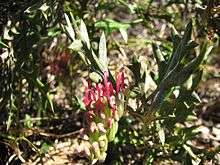Grevillea ilicifolia
| Grevillea ilicifolia | |
|---|---|
 | |
| Scientific classification | |
| Kingdom: | Plantae |
| (unranked): | Angiosperms |
| (unranked): | Eudicots |
| Order: | Proteales |
| Family: | Proteaceae |
| Genus: | Grevillea |
| Species: | G. ilicifolia |
| Binomial name | |
| Grevillea ilicifolia (R.Br.) R.Br. | |
| Synonyms | |
Grevillea ilicifolia, commonly known as holly grevillea, is a species of the plant genus Grevillea.[1][2] It is a shrub of variable form, growing to between 0.3 and 2 metres in height and 3 metres wide. Typically, leaves are lobed and holly like, but may also be unlobed. The flowers have perianths that have a base that is cream to green grading to grey-mauve. Styles may be pink, red, orange or yellow.The main flowering period in the species native range is September to November.[2]
The species was first formally described by Scottish botanist Robert Brown in 1810 in his paper On the natural order of plants called Proteaceae and given the name Anadenia ilicifolia. Brown transferred the species to the genus Grevillea in 1830.[1]
Two subspecies are currently recognised:
- G. ilicifolia (R.Br.) R.Br.subsp. ilicifolia
- G. ilicifolia subsp. lobata (F.Muell.) Downing[1]
The species occurs in south-eastern South Australia, western Victoria and limited areas in southern New South Wales.[2]
References
- 1 2 3 "Grevillea ilicifolia". Australian Plant Name Index (APNI), IBIS database. Centre for Plant Biodiversity Research, Australian Government, Canberra. Retrieved 2010-10-13.
- 1 2 3 "Grevillea ilicifolia". Flora of Australia Online. Department of the Environment and Heritage, Australian Government.